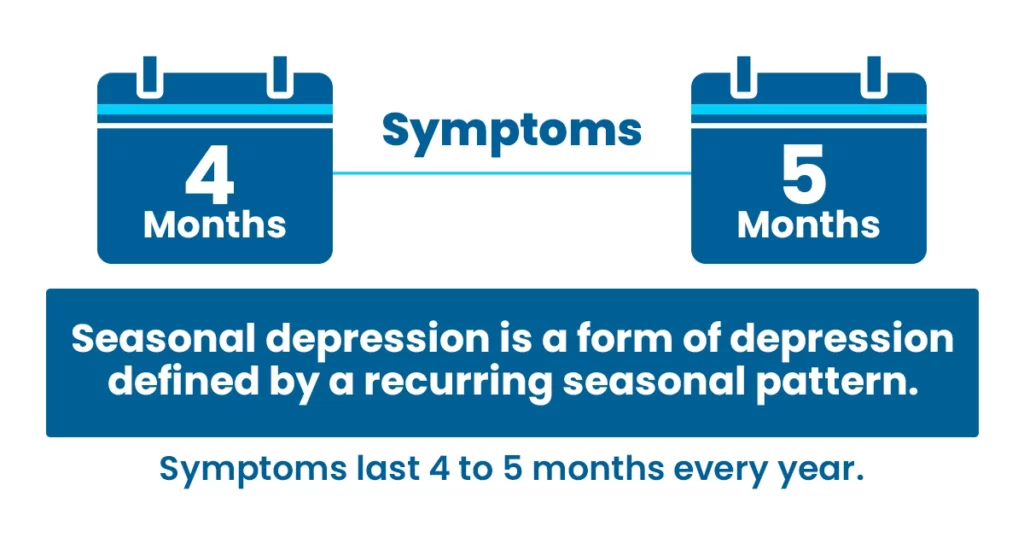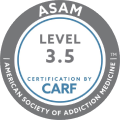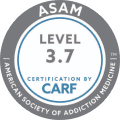
Many people go through times when they are depressed or do not feel like themselves. Sometimes, these mood swings might begin and end with seasonal changes. People may start to feel “low” when the days get shorter in the fall and winter months (also known as “winter blues”) and begin to feel better in the spring season when daylight hours get longer.
In some cases, these mood changes are more severe and can impact how a person thinks, feels, and goes about their daily activities. If you observe significant changes in your mood and behavior as the seasons change, you may have seasonal affective disorder (SAD), a kind of depression.
In most cases, SAD symptoms often appear in the late fall or early winter and start to disappear with the arrival of the spring and summer months; this is known as winter depression or winter-pattern SAD. Some people may have depressive episodes throughout the spring and summer months, known as summer-pattern SAD or less common summer depression.
According National Institute of Mental Health (NIMH), the seasonal affective disorder affects 15 million adults or 7.1 percent of the US population. SAD is reported to be more common among women and young people. According to a 2007 Anxiety and Depression Association of America (ADAA) survey, 36 percent of people with social anxiety reported experiencing depressive symptoms for ten or more years before seeking help.
Signs and Symptoms of Seasonal Affective Disorder
Seasonal depression is not a separate disorder but rather a form of depression defined by a recurring seasonal pattern, with symptoms lasting 4 to 5 months every year. As a result, the signs and symptoms of seasonal depression include those associated with major depressive disorder, as well as specific particular symptoms that differ between winter depression and summer depression. Not everyone suffering from SAD will exhibit all of the symptoms listed below.
Common symptoms of seasonal affective disorder include:
- Feeling agitated or sluggish
- Having difficulty concentrating
- Having problems with sleep
- Feeling depressed
- Having suicidal thoughts
- Being low on energy
- Experiencing changes in appetite or weight
- Feeling worthless or hopeless
- Losing interest in activities that you once enjoyed
For winter depression, additional specific symptoms include:
- Hypersomnia
- Social withdrawal
- Overeating, particularly with a craving for carbohydrates
- Weight gain
For summer depression, additional specific symptoms include:
- Anxiety
- Insomnia
- Agitation and restlessness
- Poor appetite, leading to weight loss
- Episodes of violent behavior
SAD symptoms, similar to depressive symptoms, can vary in intensity from one person to another depending on genetic predisposition and geographic location. Most people start experiencing mild symptoms of SAD in the early fall, which worsens over the darkest and shorter days of winter. Then, by the arrival of spring or early summer, SAD symptoms will start to fade, and you will feel normal and healthy again.
You must have had these cyclical symptoms for two or more years to be clinically diagnosed with SAD. Regardless of when your symptoms began or how long they lasted, it’s time to seek professional medical treatment if your depression feels overwhelming and is interfering with your life.
Causes of Seasonal Affective Disorder
Researchers aren’t sure what is the exact cause of SAD. Lack of sunlight may trigger this condition if you are prone to getting it. According to the theories:
Biological Clock Change
Your biological clock changes when there is less sunlight. This internal clock regulates your mood, sleep, appetite, and hormones. When it changes, you need to be in sync with your routine and able to adjust to changes in daylight length.
Brain chemical Imbalance
Brain chemicals, known as neurotransmitters, communicate between nerves. Serotonin, which leads to feelings of happiness, is one of these chemicals. You may already have lower serotonin activity if you are at risk of SAD. Because natural light helps regulate serotonin, a lack of sunlight throughout the winter months might worsen the situation. Serotonin levels can drop further, resulting in depression.
Vitamin D Deficiency
Vitamin D also boosts your serotonin levels. Because sunshine helps produce vitamin D, a lack of sunlight during the winter months might result in a vitamin D deficiency. This change can have an impact on your serotonin levels and mood.
Melatonin Boost
Melatonin is a brain chemical that affects your mood and sleep patterns. A lack of light during colder months may cause an overproduction of melatonin in some people. During the winter, you may feel sleepy and sluggish.
Negative Thoughts
People struggling with SAD have anxiety, stress, and negative thoughts about the winter. Researchers are unsure if these negative thoughts are a cause or an effect of SAD.
Seasonal depression, like any other kind of depression, can have a variety of causes and contributing factors. Always speak to your doctor for a proper diagnosis and make some lifestyle changes (such as regular exercise, a healthy diet, and so on) to help boost your mood and manage your symptoms of depression.
Treatment of Seasonal Affective Disorder
Treatment for seasonal affective disorder (SAD) may include light therapy, psychotherapy, and medications. If you have bipolar disorder, speak to your healthcare provider and mental health professional – it is essential to know when prescribing light therapy or an antidepressant. Both treatment options have the potential to cause a manic episode.
Light Therapy
In light therapy, you sit a few feet away from a specific light box, exposing yourself to bright light within the first hour after waking up every day. Light therapy mimics sunlight and appears to change brain chemicals associated with mood.
Light therapy is one of the first-line treatments for SAD. It usually starts working within a few days to a few weeks and has relatively few adverse effects. Although research on light therapy is limited, it appears to be effective in treating SAD symptoms in most people.
However, those people with specific eye diseases or medications that enhance sensitivity to sunlight may need to use light therapy or alternative treatments under medical supervision.
Psychotherapy
Another option for treating SAD is psychotherapy, commonly known as talk therapy. Cognitive behavioral therapy, a kind of psychotherapy, can help you:
- Learn how to cope with SAD in a healthy way, mainly by reducing avoidance behavior and engaging in meaningful activities.
- Learn how to deal with stress.
- Identify and change negative thoughts and habits that may make you feel worse.
- Build in healthful actions such as exercising regularly and improving your sleep patterns.
Medications
Seasonal affective disorder (SAD), like other types of depression, is associated with changes in serotonin activity. Antidepressant medications, also known as selective serotonin reuptake inhibitors (SSRIs), are used to treat SAD symptoms. These medications can significantly improve the moods of patients. Commonly used SSRIs for treating SAD symptoms include citalopram, fluoxetine, paroxetine, sertraline, and escitalopram.
The United States Food and Drug Administration (FDA) has also approved bupropion in an extended-release form to prevent the recurrence of major depressive episodes when taken daily from the fall until early spring.
All the medications come with side effects. Consult your doctor about the potential risks of using these medications for your condition. You may have to try many antidepressant medications before finding one that works best.
Frequently Asked Questions (FAQs)
What are the major symptoms of SAD?
The most common symptoms of SAD include:Loss of interest or pleasure in normal day activities
Low self-esteem
Becoming less sociable
Feeling stressed or anxious
Feelings of guilt and worthlessness
Feeling irritable
Low energy levels
Reduced sex drive
What is the likely cause of seasonal affective disorder?
Shorter days and less sunlight are thought to be associated with chemical changes in the brain and may play a part in the development of seasonal affective disorder (SAD).Melatonin, a sleep-related hormone, has also been linked to SAD. When it’s dark, the body produces more melatonin. As a result, as the days become shorter and darker, more melatonin is produced.
Who is at more risk for SAD?
Risk factors for developing seasonal affective disorder:A family history of SAD or other types of depression increases the risk.
Women are more prone to be diagnosed with SAD than men.
SAD is more common among those people who live far from the equator.
Young people are more likely to develop seasonal depression. The risk decreases with age.
How to deal with SAD?
Try the following tips to cope with SAD and depression.Have a diet rich in foods such as protein, simple carbs, and vitamins B12 and D
Exercise regularly
Spend time with those who make you happy
Stay away from drugs and alcohol
Get professional help
Get Over Depression with Help From The Haven Detox
If you feel depressed, tired, and grumpy around the same time every year, and these feelings appear to be seasonal, you may have seasonal affective disorder (SAD). Dont worry, as professional help is available at The Haven Detox.
The Haven Detox offers evidence-based treatment services, which include medical detoxification, residential treatment, SMART Recovery, and therapies. Our team of well-trained medical professionals is available to provide our patients suffering from SAD safe, round-the-clock medical and emotional support.
For additional information, contact us at (561) 328-8627. Our admissions counselors are available 24/7 and are happy to answer all your questions.






